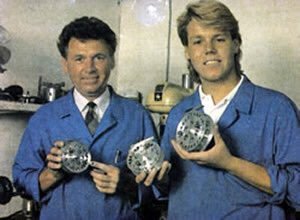

‘The Reynolds Reel’
Around 1938, Harry embarked on his journey of creating fishing reels, earning the local anglers’ admiration who lovingly dubbed it ‘The Reynolds Reel.’ Crafted with meticulous care, this remarkable reel was composed of three cast aluminum components: the reel back, the spool backplate, and the spool front. Harry skillfully finished each piece on his lathe, ensuring precision and quality.
Distinguishing itself from other reels like the Aerial or Young’s reel, Harry’s creation operated on two ball bearings, encircling a central shaft instead of a traditional ‘centre pin.’ This design choice allowed the reel to spin with exceptional fluidity, making it an ideal choice for anglers practicing trotting techniques along the local river Trent.
Harry Reynolds dedicated his craftsmanship to the production of reels in his workshop, a modest shed located at Queens Avenue in Ilkeston. To facilitate the casting process, Harry sourced the essential materials, including sand and aluminum, from the esteemed Stanton Iron Works. The brass required for the drum core pillars was obtained from a local shop, while the bearings were procured from Ransome and Marr, a reputable establishment based in Newark.
Interestingly, the notable fact that a significant portion of the reel’s materials originated from the Stanton Iron Works has led to a prevailing theory. According to this theory, it is believed that the Works management influenced Harry to rename his creation as ‘The Stanton,’ a name that has endured among collectors to this day.
During the Second World War the green, or virgin sand, needed for casting his reels was now in short supply, so Harry was unable to make any more reels until around 1942.
Harry Reynolds displayed his craftsmanship by producing reels in two different sizes: a large 4 3/4″ variant and a smaller 4″ version. These reels could be customized with handles and a check, providing anglers with options that suited their preferences. Around 1955, Derek Reynolds, Harry’s son, recalls his father charging two pounds and ten shillings for these reels.
As time went on, Harry expanded his offerings by introducing a black anodized finish as an additional choice. This finish served to diminish the shiny appearance of the aluminum on newly completed reels, catering to those who preferred a more subdued aesthetic.
In his entrepreneurial spirit, Harry would manufacture approximately six reels before embarking on a Saturday morning train journey to Sheffield. There, he would personally sell his reels in the local pubs, remaining in the city until all of his creations found enthusiastic buyers. Sheffield, renowned for having one of the largest populations of anglers in the country at the time, provided a receptive market for Harry’s reels, ensuring successful sales.
Tragically, Harry’s life was cut short in 1968 due to a fatal motor accident. Nonetheless, his legacy lives on through the enduring reputation of his meticulously crafted reels.

